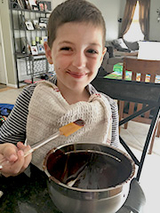Glucose Transporter Type 1 Deficiency: Dominic’s Story
Glucose Transporter Type 1 Deficiency: Dominic’s Story
Dominic’s life can be broken into two distinct parts: before and after he started the ketogenic diet.

Before was filled with repeated seizures and frequent falls, with few spoken words and staring episodes; he never seemed to connect with his family.
After is filled with breakthroughs: smiling and interacting with his family, singing a nursery rhyme, wrestling with his dogs, tying his shoes, and most recently, learning to ride a bike.
The turning point came in September 2013 when Dominic was nearly 3 years old. That is when he began the ketogenic diet. The diet is extremely high in fat — about 90 percent of his calories come from fat — but it is the only proven treatment for his rare genetic metabolic condition.
“It all felt so daunting when Dom first started the keto diet. We’d have to weigh out all of his food with a math equation,” says Maria, Dominic’s mom. “But now, it’s just part of our life. And because of it, Dominic is doing amazing.”
Early symptoms indicated epilepsy
When Dominic was about 5 months old, his mom noticed he was experiencing rapid eye movements when he was awake. As a registered nurse, Maria knew this was unusual and could be a sign of a neurological issue. She brought Dom to a neurologist who performed an EEG and an MRI. Both tests came back normal, indicating Dom was not having seizures.
Four months later Dominic had a grand mal seizure. Maria rushed him to the hospital, and Dom began medication. When the medication didn’t help, doctors switched Dom to a second medication. That too failed.
For the next 18 months, Dominic’s family took him to doctor after doctor to find out what was wrong with their little boy. His seizure-like episodes continued — while EEG testing continued to indicate he did not have epilepsy.
Maria believed something much more complex was going on with Dominic. His symptoms weren’t limited to those experienced by most children with epilepsy. He couldn’t control his movements (ataxia), could only say 3 recognizable words, and whenever he had a seizure, he would lose any recent developmental milestones he had achieved. Dominic didn’t like too much stimulation; he didn’t like music, or being tickled, or watching TV — things typically developing toddlers enjoy.
“I could see my child diminishing day by day,” Maria says. “I had to find out what was wrong with him. It consumed my life.”
Finally, Dominic’s pediatrician suggested something no specialist had before: genetic testing. And that led the family to Children’s Hospital of Philadelphia (CHOP).
Discovering the genetic cause
In March 2013, Dominic had a single sequencing genetic test to see if he had any variants that could be causing his epilepsy-like symptoms.
In July, doctors called Dominic’s family with answers. He had glucose transporter type 1 deficiency, a rare genetic disorder characterized by seizures, developmental delay, and movement disorders. The disorder is caused by a protein deficiency required for glucose to cross the blood-brain border.
“Essentially, his brain wasn’t getting enough nutrients to function properly,” Maria says. “This brain energy crisis was causing the seizure-like episodes and other symptoms.”
Getting a diagnosis was bittersweet, she says. The condition couldn’t be cured, but it could be treated. And that’s when Dom’s family first learned about the ketogenic diet and the specialized Dietary Treatment Program at CHOP.
Pediatric Neurologist Christina Bergqvist, MD, explained that the ketogenic diet has been used for nearly a century to treat patients with epilepsy by changing the metabolism of the body. Instead of using carbohydrates to produce energy, the body breaks down fat to make ketones, which then provide energy to the brain and the rest of the body. This is a metabolic state called ketosis.
Starting the keto diet
In September, Dominic was admitted to Children’s Hospital for a five-day hospital stay to transition to the ketogenic diet. During this time, Dr. Bergqvist and others monitored Dominic to ensure he would tolerate the food and safely convert to ketosis. His family learned details about how to best manage the diet when he returned home, and took cooking classes in CHOP’s Keto Kitchen.
“Within two days on the keto diet, he was a new kid,” Maria says. “His eyes came back to life. His attention span came back. He could play again.”
Within a month, Dominic was well enough to start preschool. “That’s when the milestones exploded,” Maria says. “He was learning new things every day and he was so proud of himself.”
While many improvements happened quickly, other changes took time. He eventually learned to sing Mary Had a Little Lamb, to draw stick figures, to walk without an ataxia gait, and to ride a bike. His language skills have also increased dramatically.
“He went from grunting and three words to knowing the full English language. He’s now 100 percent cognitively aware,” Maria says.
Life with Dominic
Dominic is now 7 years old and in the first grade. Outgoing and extremely social, Dominic accepts who he is and knows his challenges, Maria says.
“He’s a fighter and a really amazing kid,” she says. “He enjoys so many different things now — playing with his friends, his two dogs, Super Mario, video games, superheroes, reading, and he just started taking piano lessons.”
After 4 ½ years, Dominic is still on the ketogenic diet and probably will be for the rest of his life.

Dom definitely has his keto favorites, including a keto hot chocolate he has every morning for breakfast, hotdogs he dips in special ketchup, and a keto cereal that looks and tastes like Fruit Loops. But he eats all of the high-fat food he’s supposed to, and even knows which order to eat them in (fat, protein, carbs).
“Dom doesn’t let food run his life. It’s just fuel for him,” Maria says. “We’ve also changed our rewards so they don’t revolve around food. For example, instead of going out for ice cream to celebrate, we’ll spend a family day at the park.”
Maria says early diagnosis and the ketogenic diet have “truly saved Dominic’s life.”
With his condition stable, Dominic only needs to return to Children’s Hospital of Philadelphia every six months for checkups. He meets with the keto team, including Dr. Bergqvist, Claire Chee, BS, RN, Sue Groveman, MS, RN, LDN, Calga Fenton, RN, LDN, and others.
“CHOP has an extraordinary program,” Maria says. “Everything is about collaboration and teamwork and finding the right solution for each child. I don’t know where we’d be without them — and I’m glad we never have to find out.”